#cds 1 2020 results
Text
youtube
One and All is the 1st mini album by Boys Almighty under Rainbow Entertainment. It was released on Febraury 5, 2024. The album features 5 tracks, Hello, Future being the title track. It is available both physically and digitally.
BAM! promoted the album for 3 weeks in total. Hello, Future peaked at 10 on the Circle Chart while pre-release single Girl Almighty peaked at 14. The single also charted on the Billboard Hot 100, peaking at 28. BAM! won 6 music show awards for Hello, Future, including their first ever music show win.
ੈ✩‧₊˚ i. the tracklist !
✦ . Hello, Future ( title track ) produced by Minwoo
✦ . Polaroid Love produced by ROZE + HOWL
✦ . Daydreaming produced by DAY1 + CHASER
✦ . Graduation produced by Oliver Song
✦ . Girl Almighty ( pre-release single ) produced by ROZE
find minwoo at @intoloopin, HOWL at @idiishowl, and oliver at @plasticflwrs !!
ੈ✩‧₊˚ ii. buy the album !


✦ . Future version
. cd, photobook ( 130 p ), photocards ( 10ver. 2ea ), sticker sheet ( 1ver. 1ea ), tracklist ( 1ver. 1ea ), lyric book ( 1ver. 1ea )
. pre-orders only ; poster ( 5ver. 1ea ), polaroid card ( 5ver. 1ea ), signed polaroid ( 5 ver. 1 ea. random units )
✦ . Memory version
. cd, photobook ( 130 p ), photocards ( 10ver. 2ea ), sticker sheet ( 1ver. 1ea ), tracklist ( 1ver. 1ea ), lyric book ( 1ver. 1ea )
. pre-orders only ; poster ( 5ver. 1ea ), polaroid card ( 5ver. 1ea ), signed polaroid ( 5 ver. 1 ea. random units )





✦ . Member versions ( digipacks )
. cd, photobook ( 80 p ), photocards ( 5ver. 2ea ), stickers ( 5 ver. 2ea ), group mini-poster ( 2 ver. 1 ea )
. pre-orders only ; member key tag ( 5ver. 1ea ), polaroid card ( 5ver. 1ea )
✦ . get your photocards here !
ੈ✩‧₊˚ iii. the styling !

The styling for this era was generally casual or school themed, reminiscent of how they were portrayed in the music videos from this album. In one special stage, each member dressed up as what they wanted to be when they grew up ( pictured ; kitae as a zookeeper ).
ੈ✩‧₊˚ iv. the reception !
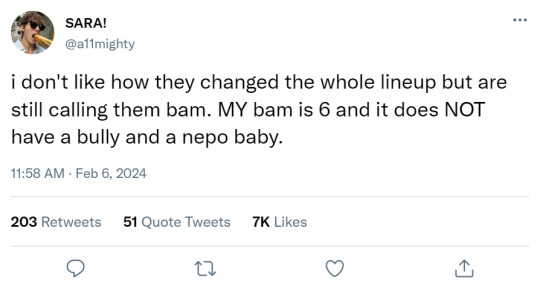





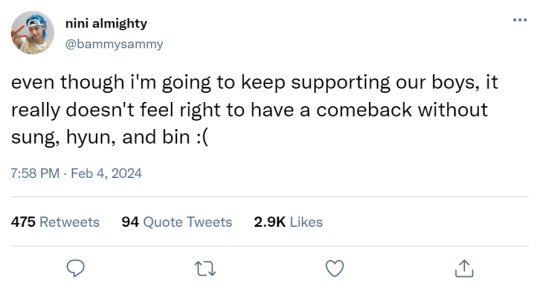


ੈ✩‧₊˚ iv. the notes !
✦ frankly, no one behind the creation of this album, from the company to the members themselves expected it to perform as well as it did
✦ thanks to the renown garnered from the pre-release single, girl almighty, the album was an instant hit
✦ the physical copies flew off the shelves, selling nearly 600 thousand in the first week
✦ a fun title track complete with exciting stages and a mv setting up the group's intriguing storyline captured the industry's attention instantly
✦ this comeback earned the group their first music show win since their original debut in 2020, resulting in a very emotional acceptance from the original 3 members of the group
✦ a video of kitae sobbing into the shoulder of a misty eyed but still smiling bo as sammy thanks the crowd through his own tears made rounds online
✦ the resentful old malos had a field day with taeyoung and kiho's less emotional reactions in comparison, but were largely drowned out by the overwhelming congratulations from all around!
✦ the title and lyrics of the title track became rather controversial, especially malos from before their redebut, believing that rainbow is promoting the idea that they saved them from their failing career by entirely overtaking and rebranding their image
✦ they released a 4 part variety show, MISSION MIGHTY, where they dedicated themselves to learning a new skill each episode to help them in their future
✦ it was clear from their vlog content, variety show, and other interview schedules that kiho and taeyoung were not quite as close as the other three members, but many brushed it off as to be expected from a (relatively) newly formed group
✦ polaroid love became super popular on tiktok, sparking a live recording rendition to be released on the group's youtube
✦ their fame only grew exponentially from their surprise pre-release, their visuals, concept, and talents capturing the hearts of millions upon millions of brand new fans
#we're gonna pretend this isn't super late <3#one and all ! ੈ✩‧₊˚ discography ✦.#kpop group oc#fictional kpop community#fictional kpop group#fictional kpop idol#fake kpop group#fake kpop idol#oc kpop#kpop oc#oc kpop idol#kpop idol oc#idol oc#fictional idol group#fictional idol community#fictional kpop oc#ficnetfairy
13 notes
·
View notes
Text








The results of April's book sale bonanza, four library sales in two weeks! Long text post incoming...
Left stack in the first photo is from one sale, right stack is two other sales, and the final photo is from the last one alone. Somehow acquired more in April than I had Jan-March combined. I don't even want to count up how much I spent, so I'm simply going to decide it was worth it because so many pretty books, exciting finds, and fun!
I will say, the craziest thing to me is that the super-mega-huge sale, the one I made an effort to drive an hour for on Wednesday night? It was indeed huge and I spent 3 hours there & had a good time, but only found seven books, pictured in the right hand stack - from The Darcys & The Bingleys up through the 3 skinny paperbacks (plus a couple of CDs I took a chance on, didn't like). And the sale that usually doesn't have much of anything, that I barely had an hour in? The best sale of the month.
I tried to organize the cover photos mainly by age group, with YA blending into adult, so I think that's actually the order in which I'm going to go through them, not least because I missed a couple of them for the stacks.
CHILDREN'S BOOKS
1. A Dog Named Wolf - Erik Munsterhjelm (1973): I snagged it mainly because vintage dog/wildlife novel, but then I realized it's actually on my OpenLibrary TBR, so now I don't have to read it that way!
2. Mr. Cat - George Freedly (1960): not really a kids' book but small enough to put here. Apparently a bind-up w/ "More Mr. Cat" but I cannot imagine how short these were originally, as together in a mass market paperback it's still only 160 pages. I assume he was already a famous enough writer, even if only at a newspaper, to be granted the indulgence of publishing a memoir about his cat....
[edit: "theatre critic, librarian and founder of the Theatre Collection of the New York Public Library, Freedley was a regular columnist for PLAYBILL, and the drama critic, book editor, and feature writer for the Morning Telegraph (New York)"]
3. The Black Pearl - Scott O'Dell (1967, 70s edition): not unlike Call it Courage, this is another one I remember really liking in elementary school but the details have been forgotten.
4. BSC Super Special #7: Snowbound: only grabbed because it was super-cheap; it's not in great condition but super-specials are a little harder to spot in the wild so while I'm not trying to collect this massive series, I can't help having a soft-spot for a few reps. (side note: the Karen/Little Sister novelty book "School Scrapbook" was also there, which I thought might be a fun collectible, but it had already been mostly filled out by its previous owner. Still fun to read her answers, though! I would cherish having something like that from my own 3rd grade year).
5. Two-Minute Mysteries - Donald J. Sobold (1967, 90s edition): even though a teacher's name is inked on it, I couldn't resist this nostalgic read! My 4th/5th grade teacher used to read these aloud to us and challenge us to solve them, and you know what? They're STILL kind of hard to solve. You have to pay really close attention to specific wording and tiny details.
6-7. Animal Inn #3 + 6 - Virginia Vail: remember this series I love? By wild coincidence, these are the exact same ones I read from a Little Free Library in 2020, but where those copies were in horrible water-damaged shape, these are as good as can be expected from cheap-pulp kids' paperbacks of the 80s
8. The Dog In My Life - Kurt Unkelbach (1966): yay! I'm interested in all his books but have been wanting to read this ever since I solved it on a Goodreads "What's The Name of That Book?" queries (one of my first, and one I worked very hard on finding!)
9. The Black Stallion & the Girl - Walter Farley (1971): only grabbed this because it was so cheap; it's not in great shape and I probably won't keep. I always wanted to love this series more than I actually did growing up -- everyone who likes horse books always says this is their favorite, and I just never got the hype beyond the first couple! -- but there were a few I really liked. Maybe this could be one of them.
10. A Summer of Horses - Carol Fenner: I see an 80s teen horse book paperback, I buy. Unsure if I'll keep it after reading, but it's not that thick so probably.
11. Flash of Phantom Canyon -- Agnes Ranney (1960s): I see a vintage Scholastic horse book, I also buy. I ended up deciding to read this right away, mostly because it was small and light and easy to carry in a shoulder bag while walking on trails in search of a good reading bench. Honestly, it's as much historical fiction/history lesson as it is horse book and if I ever make myself weed through the Scholastic Stack this is probably a donation candidate...but not just yet.
12. The Stallion of Box Canyon (1997): part of the Treasured Horses collection I owned several of as a kid from Scholastic book orders and LOVED, but sold off when I outgrew them, and have now been grabbing back. When I learned in 2020 that there were model horses to go with them, as well as more books than I knew about, my interest increased, and this one about a Mustang was my #1 most wanted!
13. Foxy - Helen V. Griffith (1984): Dog book! I think I read this in elementary school but want to be sure. May or may not keep, depends how sad it is.
14. The Collector - K.R. Alexander (2018): the modern-day counterpart to Mary Downing Hahn, I freaking love this scary-as-hell cover. I listened to it on audio but I wanted a physical copy as well.
15. The Sun Will Come Out -- Joanne Levy (2021): it was simply too beautiful and pristine -- it looks off the shelf new -- not to buy, knowing I could flip it to Half Price. I think I probably will do that now that I've read it, but I did enjoy it.
16. The Diddakoi - Rumer Godden (1972): figures that I find it just one year after I finally caved and read it on OpenLibrary last year after 6 years on my TBR. But this is the first time I've seen a physical copy. This edition is not my favorite cover so I'm not sure if I really want to keep it, but I did enjoy the book.
17. Tucky the Hunter - James Dickey (1978): pictured in the last photo, I bought one (1) picture book because the illustrations were so beautiful, and the rhyming text written in calligraphy. Do I agree with the story theme of a child dreaming about all the animals he wants to shoot? Not really, but...
YA/TEEN
1. Seventeenth Summer - Maureen Daly (1942, 2006 edition): it's only a mass market paperback, but still thrilled to finally have this classic in my hands to read when ready!
2. City of Darkness - Ben Bova (1976): I just couldn't resist the premise of this one -- Manhattan is now under a dome and only "open" in the summer as a tourist spot, but a kid sneaks in and gets stuck there to find out that gangs secretly live there year-round, fighting for sheer survival? I intended to read & release because it's not in the best condition, so I read it right away, but now I think this is so creative I want to keep it around.
3. In the Hand of the Goddess (Alanna #2) (1984, 2011 edition) - Tamora Pierce: ex-library but I think I can peel the tape/stickers off. I've decided to collect both this version of the series and the mass-market paperbacks as I find them because I love them equally for different reasons.
4. In Front of God and Everybody: The Confessions of April Grace - K.D. McCrite (2011): technically middle grade but putting it here because it's a visual match. I saw this at the sale a few years ago but gave it a pass because it was Christian fiction. Now that bothers me less, and I'm so glad I changed my mind because I read it last week and it was HILARIOUS and I want the rest of the quartet. (also very minimally "Christian Book" -- it shows only in that the family goes to church/says a blessing before dinner and lives by the principle of "be kind to others no matter how ungracious they are")
5. Pretty Fierce - Kieran Scott (2017): a 5-star swoon-worthy YA spy thriller! So happy it's mine.
6. Top Ten - Katie Cotugno (2017): as recently mentioned in the reading triage, this is ex-library w/ a broken spine so I mainly bought it to dismantle for the snapshots on the cover and endpages, but then I realized ah heck, this sounds pretty good and I want to read it after all. I'm 70 pages in and really enjoying it, but saving it for the sunny days.
7. What Comes After - Steve Watkins (2011): one of my standout YA reads in *checks notes* actually 2011, wow! I still think about it regularly -- orphaned teen is sent to live w/ only remaining relatives, an abusive aunt & cousin; finds solace in caring for the goats
8. This Is What It Feels Like - Annie Barrows (2018): has been on my summer TBR 2 or 3 years running, now I can stop worrying about when the library will weed the last copy.
9. In Real Life - Jessica Love (2016): an underrated read from, I think, 2018? Again with the sweet romance.
10. The Girls of No Return - Erin Saldin (2012): a much more serious book about girls in a wilderness therapy camp/school that really impressed me, thrilled to have one in pristine condition.
ADULT FICTION
Now we're gonna mix it up a little as fiction and non aren't separated in the above photos, mainly to match size & color, but I'm listing all the fiction first.
Driftwood - Elizabeth Dutton (2014): I thought it was a misplaced YA when I bought it, until I started reading and MC is twenty-eight. It promised a solo California road trip, following a route left in letters by her late father, so I decided to take a chance. It seemed so perfect for the weather I ended up starting it in a nearby park before I even went home, and finished the next day. 3.5 stars rounded up to 4, I'm glad I bought it
2. The Amazing Adventures of Kavalier & Clay - Michael Chabon (2000): I bought husband a brand-new copy of the newer edition w/ four extra short-stories in the back, which he never read and now I'm kind of glad he didn't so it stays pristine in a way only I can manage, and meanwhile, I decided to get this one too because it is MUCH, MUCH floppier and more comfortable to read.
3. Maurice - E.M. Forster: I've never read this and kind of want to. I've started making it a habit to look for nice editions of classics at these sales, and while this isn't amazing, it's like new, a floppy paperback, AND it has horses on the front, so.
4. Where the Forest Meets the Stars - Glendy Vanderah (2019): I've been flirting with the idea of reading this and while my library DOES have it, I'd love a perfectly-new copy of my own for $2.
5. The Haunting of Gillespie House - Darcy Coates (2015, 2020 edition): same with this one. I still can't believe that after discovering a whole shelf of her books at the library in 2022 and being like "I'm gonna read them all!", I actually only read one. But this was definitely high on my interest list!
6. The Darcys and the Bingleys - Marsha Altman (2008): had there been more at this particular sale I wanted, I might not have bought it, but the library doesn't have it and my interest is piqued by this P&P fanfiction sequel (which...is the first of ten in a series?? good lord this one is already large enough).
7. Coffee Train - Margarethe Erdahl Shank (1953): It's in terrible shape -- awful foxing on the pages -- so I really shouldn't have, but I'm Intrigued by this vintage read; my family has no Scandinavian roots but much of Minnesota (including my husband) does so I have a soft spot for it. Even though this takes place in the state next door, I think it will be very charming.
Through the eyes of little Mugs, a Norwegian-American girl, we see life in North Dakota with Norwegian Lutherans in the days following World War I.
8. The Dogs of Christmas - Bruce Cameron (2013, 2018 edition): I absolutely loved this book and this is the "author's preferred edition" with an extra chapter at the end! I saw it at a garage sale 3 years ago and resisted like an IDIOT who was trying not to over-buy books she didn't ~need~; have regretted and been looking for this version ever since, now it's mine.
9. The Christmas Dog - Melody Carlson (2009): I couldn't resist this slender novella. This year's December reading is gonna be SO CHRISTMASY I swear it.
10. Christmas at Corgi Cove - Annie England Noblin (2023!): aaand now I am back up to owning 3 unread books by her after having only read 1 and given it 3 stars. But hope springs eternal and all that.
11. Roxane the Blue Dane - Alice Kingham-Lechevre (1988): "a series of short stories chronicling the relationship between the author and her favorite show dog, Roxane, told from the perspective of the great dane." Takes place in France, so I had a devil of a time trying to figure out why this author was famous enough to write about her pet, and finally deduced she was a decently well known English/French artist/illustrator, particularly of animals, born late 19th century. It seems quite wonderful from the chapter or two I've read.
12. The Sccrets of Pistoulet - Jana Fayen Kolpen (1996): this one I'm actually really excited about because a) it's in a slipcase, which I didn't previously know because I read a library copy, and b) I spotted it in the cookbooks section I only ever skim (for Susan Branch). I don't actually love the story, which is a murky magical-realism adult fable set in France, but I do love that it's mixed-media with transparent overlays, at least one card that opens up, and several recipe cards you can physically remove from envelopes.
NONFICTION
1. Unauthorized X-Files -- Hatfield/Bur (1996): I would have climbed over people to get my hands on this in high school. "In this ultimate game book for X-philes, the authors have put together a collection of trivia challenges: Some are based on specific episodes from the first three seasons (brief episode summaries are provided); others address behind-the-scenes and on-the-set information, site locations, dialogue between characters, more. Testing methods vary, ranging from multiple choice to fill in the blank. Also included are actor and character profiles, memorable Mulderisms, and scintillating Scullyisms!"
Even though it's limited to the years of TXF I mostly avoid rewatching, the vestigial Phile in me is still intrigued. By the same authors, I also saw Unauthorized X-Cyclopedia, which tempted me, but I figured I'm unlikely to actually use it for reference and tbh, it'll just annoy me that it doesn't cover the full series.
2. Growing With the Grass - Ted Hall (1992): a small local press-published memoir of a boyhood circa the 1920s, arranged as a collection of brief anecdotes & vignettes, snagged because Old Frontenac is a lovely day trip visit and still just as much of a village as ever. I don't know if this will fully be to my tastes or a keeper, but I couldn't resist.
3. House Lessons - Erica Bauermeister (2020): a memoir of restoring an old house on an island off the coast of Washington, crossed w/ life lessons. Would you believe I was on a Libby waitlist for the audio for three months as our library doesn't have a physical copy, finally finished it during first week of driving to book sales, and then found a physical copy at the last one! Decided I liked it enough to own, at least for a while. Plus physical copy has little sketches before each chapter!
4. The Big House A Century in the Life of an American Summer Home - George Howe Colt (2003): now for the opposite coast...I think I put this on a TBR before; our library only has one copy and I really want to read it but I'm never quite in the mood. Now it's mine forever!! (I was SO excited to find this with you lmao)
5. Cold Antler Farm - Jenna Woginrich (2014): I read her first book twice (Made From Scratch), and while unfortunately there are 2 more memoirs to go before I chronologically reach this one and the library doesn't have any, I'm really excited I have this one!
6. Connemara Mollie - Hilary Brandt (2012): I'm ALSO super excited to try this one, never heard of it but it's a memoir of a long-distance pony trek the author took around Ireland in 1984.
7. Brother Super - Bill Rice (1961): Pet memoir about another Great Dane, this time a family pet.
OTHER MEDIA (not pictured)
Audiobooks: When We Were Lost by Kevin Wignall, a cracking good YA adventure about a plane crash in the jungle, and Why Not Me?, so now I have both of Mindy Kaling's memoirs in her voice! (someday I'll listen to it...)
DVDs: Spiderman: No Way Home; Uncharted
CDs: Patty Larkin - "Watch the Sky," and Matt Wasner's eponymous album/limited advanced edition copy (I took a chance on these based on appearance, because nothing is more fun than guessing right on something random that becomes a new fave!, but unfortunately I didn't like either of them so they will be leaving)
2 notes
·
View notes
Text
Stocks Up, Gold Down in Americans' Best Investment Ratings
Real estate continues to lead as the perceived best long-term investment
— By Jeffrey M. Jones | May 15, 2024

Washington, D.C. — Americans continue to rank real estate as the best investment for the long term among six options. Thirty-six percent choose real estate, followed by stocks or mutual funds (22%), gold (18%), and savings accounts or CDs (13%). Relatively few Americans believe bonds (4%) or cryptocurrency (3%) are the best long-term investments.
The percentage of adults choosing real estate is similar to a year ago, but more identify stocks and fewer name gold as the best investment this year. Stocks were last higher than now in 2021, when 26% chose them, while gold has returned to more typical levels after an increase last year.
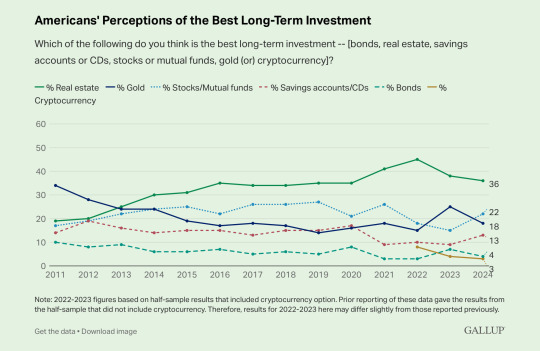
The latest results are based on Gallup’s annual Economy and Personal Finance survey, conducted April 1-22. Since 2011, Gallup has asked Americans to choose among real estate, stocks, gold, savings accounts and bonds as the best investment. Cryptocurrency was added as an option in 2022.
Real estate has topped the list each year since 2014, with between 30% and 45% (in 2022) selecting it. In 2013, real estate essentially tied for first with gold and stocks; it trailed gold in 2011 and 2012.
Americans’ historical tendency to choose real estate as the best long-term investment is consistent with their usual expectations of rising local home values.
Earlier surveys conducted between 2002 and 2010 that did not include gold as an option typically found real estate or stocks as the top choice. However, several 2008-2010 surveys showed savings accounts finishing first or tied for first. Those Great Recession-era polls were conducted at a time when housing and stock values suffered deep losses, making the security of savings accounts seem attractive for investors.
The recent performance of real estate and stocks likely explains their high position on the list this year. U.S. real estate values are down from the record high in the fourth quarter of 2022, when the median home sale price was $479,500. However, they remain well above the average values from early 2021 and before. Stock values also reached new highs this year, according to the major U.S. stock indices.
Upper and Lower Income Adults Diverge on Value of Stocks, Savings Accounts
Americans at all income levels perceive real estate as a better investment than other options. However, people from different income groups disagree on the value of other investments, most notably stocks and savings accounts.
Whereas 31% of upper-income Americans say stocks are the best investment, 14% of lower-income Americans agree. Lower-income Americans are more likely to pick gold (23%) or savings accounts (20%) than stocks. Just 7% of upper-income Americans believe savings accounts are the best choice for investors.
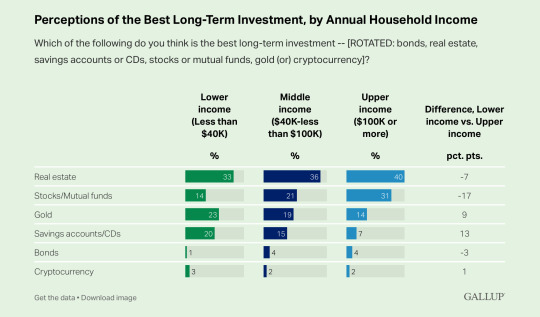
Beyond variations among income groups, there is a consistent political party difference in perceptions of gold’s value. Currently, 27% of Republicans pick gold as the best investment, compared with 7% of Democrats and 18% of independents. Last year, a trend-high 38% of Republicans named gold, compared with 12% of Democrats and 27% of independents.
In each year of the trend except 2013, Republicans have been significantly more likely than Democrats to say gold is the best investment. However, the gap between Republicans and Democrats has widened significantly since 2020.
During the past five years, Republicans have also diverged from independents in views of gold. Between 2012 and 2019, Republicans and independents were about equally likely to choose gold as the best investment.
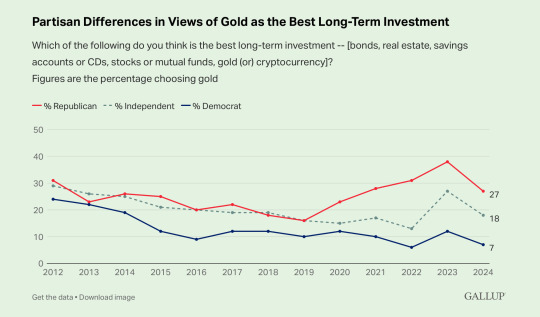
Members of almost every key subgroup are more likely now than a year ago to say stocks are the best investment and less likely to say gold is. The major exception to these patterns is found among Americans aged 55 and older, whose opinions are unchanged from a year ago.
Stock Ownership Holding at Higher Level
Gallup’s annual update finds that 62% of U.S. adults have money invested in the stock market, including individual stocks, a stock mutual fund or a retirement savings account. The figure is essentially unchanged from last year but reflects a return to stock ownership levels not seen since the Great Recession in 2008.
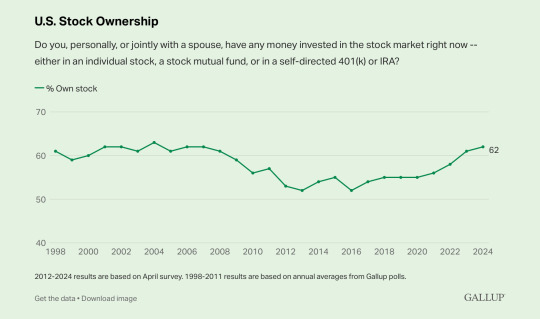
Stock ownership is highly correlated with income. The vast majority (87%) of upper-income Americans, those with annual household incomes of $100,000 or more, own stock. That compares with 25% of lower-income Americans (those whose annual incomes are less than $40,000). About two-thirds of middle-income Americans, 65%, own stock.
Bottom Line
For most of the past two decades, real estate values have grown, and those increases were especially large between 2021 and 2022. As such, it is not surprising that Americans have consistently believed real estate is the best long-term investment, even though other sources, particularly stocks, have also shown steady growth over time.
Stock values reached record levels earlier this year, and those higher values help explain why more Americans than a year ago think stocks should be the top choice for investors. The increase has come mainly at the expense of gold, which briefly was the top pick in 2011 and 2012 when real estate and stocks weren't performing as well as now.
#Economy#News.Gallup.Com#Best | Investment | Ratings#Stock | Gold | Up & Down#USA 🇺🇸#All Gallup#Headlines#Business#Business & Industry#Investors#Trade & Investment
1 note
·
View note
Text
Effective Density within a City
What’s the “best” density for the design of cities today?
Features that result in an effective density for cities today include developing mixed-use buildings, incorporating efficient walkability, integrating green infrastructure, maximizing parking space, and building up not out. When all these attributes are blended into a city, it typically results in an ideal density. The objective should balance individual space and density to encourage people to interact harmoniously which ultimately stimulates a flourishing city.
Where can this be found in Cincinnati?
Within the neighborhoods of Clifton, there are exemplary instances where effective density is prominent. According to the 2020 census, Clifton contained 4,118 houses and was 1,200 acres. This comes out to a housing density of 3.4 units per acre. The density consists of various urban planning elements, particularly along Ludlow Avenue and the surrounding areas, which has resulted in an urban environment that exemplifies the best qualities of city living. The strategic development of mixed-use buildings seamlessly blending housing and business brings a dynamic and diverse community along prominent streets such as McMillan, Calhoun, and Ludlow/Gaslight District. A strong emphasis on walkability is evident with abundant accessibility to core streets full of businesses on the lower level and residential living on the stories above. As well as close access to Cincinnati Parks such as Burnett Woods and communal green spaces like USquare on Calhoun. The use of underground parking garages not only maximizes space throughout the city but also helps to a cleaner and more efficient urban layout. The reflection of the housing density of 3.4 units per acre is proof of the success of many thoughtful urban planning strategies to create a more vibrant city.

Image 1: Ludlow Avenue

lmage 2: USquare Rendering

Image 3: Burnett Woods
References
Image 1:
https://www.google.com/url?sa=i&url=https%3A%2F%2Fwww.pinterest.com%2Fpin%2Fclifton-cincinnati-my-current-city--11681280262058942%2F&psig=AOvVaw2UVOEpbwipdBi7rkFUt-iJ&ust=1707498977968000&source=images&cd=vfe&opi=89978449&ved=0CBMQjRxqFwoTCNDkk8KfnIQDFQAAAAAdAAAAABAN
Image 2:
https://www.google.com/url?sa=i&url=https%3A%2F%2Fwww.pinterest.com%2Fpin%2F222717144047580262%2F&psig=AOvVaw1ovvD0crCr5lrf3d5KRXaI&ust=1707499069059000&source=images&cd=vfe&opi=89978449&ved=0CBMQjRxqFwoTCLDfsO2fnIQDFQAAAAAdAAAAABAE
Image 3:
https://www.google.com/url?sa=i&url=https%3A%2F%2F365cincinnati.com%2Fburnet-woods%2F&psig=AOvVaw0JMrquXAkfeEeq5lSP01gY&ust=1707499252089000&source=images&cd=vfe&opi=89978449&ved=0CBMQjRxqFwoTCIiP0sSgnIQDFQAAAAAdAAAAABAR
0 notes
Text
[Delving into MAD STARS 2023 Winners] 4 Grand prix! Cheil Worldwide's 'Knock Knock'

The 'Knock Knock' campaign, crafted by Cheil Worldwide, clinched a remarkable total of 12 trophies at MAD STARS 2023, boasting 4 Grand Prix, 5 Gold, 1 Silver, 1 Bronze, and 1 Crystal!

The collaboration between ‘Cheil Worldwide’ and the ‘Korean National Police Agency’, the 'Knock Knock’ campaign, raises the question: What ingenious idea led to its triumphant success?
In the past 8 years, domestic violence in Korea has surged by 718%. According to police statistics, reported cases of domestic violence totaled 245,064 in 2019, 221,824 in 2020, and 218,669 in 2021. Experts attribute this increase to the extended periods victims and perpetrators spend together due to social distancing and lockdown measures, making reporting even more challenging.

Designed with this challenging context in mind, 'Knock Knock' addresses situations where victims of domestic violence, child abuse, or dating violence find it difficult to directly report to 112 when sharing the same space with the perpetrator.



The campaign introduces an emergency phone system that enables victims to silently alert police about their danger, allowing them to dial 112 on their mobile phones, 'knock knock' just twice knock any number afterward. This action signals the police, who then send a link to the caller's mobile phone for real-time video transmission, location verification, and secure chat functions, facilitating optimal immediate response.
To implement this, over 4,800 emergency hotline counselors from the National Police underwent training to recognize crises solely by the 'Knock Knock' sound, resulting in a significant 42% increase in reported cases of domestic violence.
The initiative not only will benefit crime victims but also serve as a valuable tool for witnesses to various crimes, such as voice phishing, assault, and drunk driving, who wish to report without exposing themselves.
The success of 'Knock Knock' at MAD STARS 2023 lies in its life-changing campaign nature, language-agnostic adaptability, and sustainability as a long-term solution beyond a single campaign.
Providing a platform for victims to report without hesitation, 'Knock Knock' is a beacon of courage in challenging circumstances.
Experience the campaign now on the MAD STARS archive!
⬇️ Curious about 'Knock Knock'? ⬇️
youtube
⬇️ Want to know the behind-the-scenes story of 'Knock Knock'? ⬇️
#festival#advertising#busan#marketing#creative#digital#madstars2023#madstars#awards#award#award winning#case study#case studies#cheil#police#Youtube
0 notes
Text
Georgia election case prosecutors cite fairness in urging 1 trial for <b>Trump</b> and 18 other defendants
New Post has been published on https://www.google.com/url?rct=j&sa=t&url=https://apnews.com/article/trump-georgia-election-indictment-trial-ce215bfe9ff54fe389796e2faad4a948&ct=ga&cd=CAIyGjUzM2UwMTY5ZmFhZTIwMGQ6Y29tOmVuOlVT&usg=AOvVaw3Nz6C3-9D6G_1uzokoZEd2
Georgia election case prosecutors cite fairness in urging 1 trial for Trump and 18 other defendants
Prosecutors who have accused former President Donald Trump and 18 others of participating in an illegal scheme to overturn the results of the 2020 …
0 notes
Text
Lupine Publishers | The Risk of Hospitalization due to COVID-19 in Patients with Inflammatory Bowel Disease

Abstract
Objectives: The novel coronavirus SARS-CoV2 became a worldwide pandemic in 2020. It is known that patients with inflammatory bowel disease (IBD) are at an increased risk of infection, particularly when on immunosuppressive therapy. The outcomes of COVID-19 in IBD patients remain somewhat unclear.
Methods: This Finnish retrospective observational cohort study enrolled 74 patients with an established IBD diagnosis and a confirmed COVID-19 infection. Patient data (age, sex, body mass index, IBD type, biochemical and clinical activity, comorbidities [Charlson comorbidity index [CCI]) and symptoms of COVID-19 were compared with hospitalization due to the COVID-19 infection.
Results: We found that older age (p < 0.01) and comorbidities (CCI score higher than one [p < 0.01]) were associated with hospitalization due to COVID-19 infection. In contrast, none of the studied pharmacological treatments for IBD, IBD type or disease activity were associated with a higher risk of hospitalization.
Conclusion: Our study shows that comorbidities and older age are associated with hospitalization due to COVID-19. On the other hand, different pharmacological treatments for IBD were not linked to a higher risk of hospitalization.
Keywords:Inflammatory bowel diseases; Crohn’s disease; Ulcerative Colitis; COVID-19; Immunosuppressive Treatment
Introduction
The coronavirus pandemic is a worldwide health crisis brought on by severe acute respiratory syndrome coronavirus 2 (SARS CoV 2), which causes a COVID-19 (coronavirus disease 2019) infection [1]. The disease has continued to spread globally and was classified as a pandemic on 11 March 2020, by the World Health Organization [2]. Clinical symptoms in COVID-19 vary between patients, but most individuals have a mild form of the disease with no or flu-like symptoms, including a dry cough, fever, runny nose and fatigue. Additional symptoms may comprise shivering, throat pain, anosmia, headache, joint pain, nausea and diarrhoea [3,4]. In more severe forms of the disease, marked inflammation and progressive pneumonia occur, leading to difficulties in breathing. A COVID-19 infection has often proved to be more severe in patients over 60 years of age. Furthermore, most patients with COVID-19 requiring hospitalization or intensive care unit (ICU) admission have been shown to have at least one comorbidity, such as chronic lung or heart disease, diabetes or conditions that affect their immune system [5]. In addition, smokers have been suggested to develop more severe symptoms of COVID-19 and are more likely to be admitted to intensive care, to need mechanical ventilation or to die than to non-smokers [6].
The treatment of inflammatory bowel disease (IBD), including Crohn’s disease (CD) and ulcerative colitis (UC), frequently includes immunosuppressant medications [7-10]. The immunomodulators commonly used in IBD are corticosteroids, thiopurines, methotrexate, calcineurin inhibitors, anti-tumour necrosis factor agents or other biologicals. Their modes of action differ from each other, but they all compromise, to some extent, the patient’s immune response [11]. This may increase the patient’s risk of viral and bacterial infections and adverse outcomes of COVID-19 [12,13]. However, published data on possible associations of immunosuppressive therapy with severe COVID-19 remain inconsistent. Data extracted from the international registry Surveillance Epidemiology of Coronavirus Under Research Exclusion for Inflammatory Bowel Disease (SECURE-IBD; 1,439 cases, 112 with severe COVID-19) suggest an increased risk with thiopurines either combined with biologicals or as a monotherapy [14], whereas data from the French national health system (268,185 IBD patients, 600 hospitalizations) indicate no such association [15]. So far, there is no clear evidence for an increased risk of more severe outcomes in patients with IBD in the context of COVID-19. This study aimed to describe how COVID-19 presents and evolves in patients with IBD and to identify potential risk factors that may predict the severity and outcomes of a COVID-19 infection in IBD patients.
Methods
This was a retrospective, observational cohort study. All eligible patients were adults (18 years and older) with an established diagnosis of CD or UC and a confirmed diagnosis of COVID-19, which was defined as the PCR-confirmed presence of the SARS-CoV-2 genome in a nasopharyngeal swab. The Hospital District of Helsinki and Uusimaa is the largest hospital district in Finland, covering a population of more than 1.7 million. The IBD registry is an integrated platform of the hospital patient data system and comprises 5,194 secondary or tertiary care patients with an IBD diagnosis, treated mostly with immunosuppressants and biologicals. We identified IBD patients with a COVID-19 diagnosis by performing a search combining the hospital district’s COVID-19 registry and the IBD registry. The more detailed patient and disease data were collected retrospectively from the patient electronic charts in April 2021. For all eligible patients, we collected the following data: age, sex, ethnicity, pregnancy, body mass index, IBD type, IBD duration, surgical IBD treatment, pharmacological IBD treatment, other comorbidities (expressed with the Charlson Comorbidity Index [CCI] [16] signs and symptoms of COVID-19 (fever, cough, dyspnoea, dysosmia/dysgeusia, pharyngitis, diarrhoea, arthralgia-myalgia/ asthenia, rhinitis, dysphonia, headache, abdominal pain, nausea/ vomiting, thrombosis), antibiotic and anticoagulant therapies for COVID-19, COVID-19 outcomes (hospitalization on a regular ward and in an ICU as well as death), and smoking status.
Data on faecal calprotectin (FC) as a surrogate marker of inflammation were recorded 0–6 months before the COVID-19 infection, during the COVID-19 infection and after the COVID-19 infection. Values considered to be normal for FC were < 200 μg/g [17,18]. The last registration on clinical activity of IBD was assessed based on patient charts. Clinical disease activity was determined according to the presence or absence of symptoms due to IBD (number of bowel movements, presence or absence of abdominal pain and presence of blood on defecation). The Charlson Comorbidity Index (CCI) is a validated and easily applicable method of estimating the disease severity and the risk of death from a comorbid disease. It has also been shown that a higher mean CCI score is significantly associated with mortality and disease severity in COVID-19 patients [19].
Statistical analysis
Statistical analysis was performed using the R software environment (version R-3.6.2). Differences in the hospitalization status and the studied variables were tested for significance using logistic regression, where the age and BMI of the patients served as confounding factors. Statistical significance was set at p < 0.05. The values are presented as numeric with percentage or as mean with SD.
Ethical considerations
Permission to conduct the study was received from the institutional review board of Helsinki University Hospital. As this was a retrospective, non-interventional patient records review study, no ethics committee approval was required.
Results
Study population
Between 29 January 2020 and 15 April 2021, 74 patients with IBD (CD n = 32 [43%], UC n = 42 [57%]) had been diagnosed with a COVID-19 infection. The patients’ baseline characteristics are shown in (Table 1). Within the six months prior to the COVID-19 infection, 18% (n = 13) of the CD patients and 18% (n = 13) of UC patients had an active IBD. Based on the available data, 22% (n = 7) of the CD and 24% (n = 10) of the UC patients had a biochemically active disease, whereas 28% (n = 9) of the CD and 19% (n = 8) of the UC patients had a clinically active disease. Six percent (n = 2) of the CD patients and 19% (n = 8) of the UC patients were not on any pharmacological treatment for IBD at the time of COVID-19 diagnosis. At the time of COVID-19 diagnosis, three patients (4%) were on systemic corticosteroid and thiopurine combination therapy; of these, only one UC patient was hospitalized on a regular ward and did not require ICU admission. We identified only one patient who was on concomitant medication with systemic corticosteroids, thiopurine and biologicals, and this patient was not hospitalized. Seven CD patients (22%) and eight UC patients (19%) were treated with thiopurine and biologicals, of these, one patient with CD and one with UC were hospitalized on a regular ward. Overall, two patients were pregnant, and neither of them was hospitalized. Nearly threequarters (72%, n = 23) of the CD patients and two-thirds (60%, n = 25) of the UC patients had no significant comorbidities (CCI 0). One comorbidity was present in 22% (n = 7) of the CD patients and in 19% (n = 8) of the UC patients. Hence, only 15% of all patients had two or more comorbidities. Seven patients (9%) had asthma, while none had been diagnosed with chronic obstructive pulmonary disease. For 36 patients, an FC value determined 0–6 months prior to the COVID-19 infection was available: the average value for CD patients was 279 μg/g and for UC patients 421 μg/g (FC range in all patients 5–1,600 μg/g, SD 482 μg/g). During the study period, 13 (18%) patients were hospitalized, four (5%) were admitted to an intensive care unit, and one patient died (Table 2). Except for the patient who eventually died, no-one needed mechanical ventilation. Among all hospitalized patients, the average number of days spent on a regular ward due to COVID-19 was 3.7 for CD, 6.3 for UC and 5.7 for all patients. Most patients (n = 62, 84%) were not on antibiotic therapy at the time of the COVID-19 infection. After the COVID-19 diagnosis had been established, 43% (n = 32) of all patients and 100% of those hospitalized received thrombosis prophylaxis.
COVID-19 symptoms
The most common COVID-19 symptoms, presented in Table 2, were cough (56%), rhino-pharyngitis (51%), fever (46%), headache (34%), dyspnoea (26%), diarrhoea (24%), arthralgia/myalgia (16%), dysosmia/dysgeusia (15%), flu-like symptoms (13%), abdominal pain (12%) and nausea/vomiting (9%). Five percent did not develop any symptoms due to the COVID-19 infection. No thromboembolic complications were diagnosed.
Factors predicting hospitalization
In all statistical analyses age, body mass index (BMI) and sex were examined simultaneously with the variable, and each variable was also examined alone. Increasing age was associated with a higher risk of hospitalization (p < 0.01), presented in (Figure 1A). With a CCI of two or more, the risk of hospitalization was significantly increased (p < 0.01 vs CCI 0–1), as seen in (Figure 1B). When the points for age were omitted from the CCI score, patients who had points due to an underlying medical condition were still more likely to be hospitalized (p < 0.01 vs no underlying medical condition).
Factors not predicting hospitalization
We could not demonstrate any significant association between BMI and risk of hospitalization, although there was a trend towards such a risk (p = 0.09). Interestingly, there was a significant association between BMI and hospitalization when one patient with a BMI of 54 was removed as an outlier (p = 0.02) (Figure 1C). Neither sex nor IBD type (UC or CD) had a significant impact on COVID-19 outcomes. There was no significant difference in hospitalizations among patients on biological medication, thiopurines or systemic corticosteroids, nor among patients who were taking any of the said medications as a combined therapy.
Discussion
Our study, which aimed at identifying risk factors for COVID-19 in IBD patients confirms previous findings indicating an association between hospitalization and both comorbidities and older age. Importantly, the use of any medication as maintenance therapy for IBD was not associated with an increased risk of a more severe COVID-19 infection or an undesirable outcome. The data of SECURE-IBD are likely to drive treatment recommendations for IBD during the COVID-19 pandemic. Immunosuppressive medications, especially thiopurines, used to treat IBD may result in a degree of immunosuppression, which has been hypothesized to lead to a more severe COVID-19 infection. Most of the patients in the IBD registry were on immunosuppressive treatment and were therefore thought to be at a higher risk of a severe COVID-19 infection. A recently published review article by Al-Ani and colleagues encourages the continuing of usual maintenance medications and highlights the importance of avoiding corticosteroids [20]. The finding of our study are in line with previous studies. In the case of an IBD flare-up, the risks and benefits of the treatments should be carefully discussed with the patient. More severe COVID-19 has been associated with older age and obesity [21-24]. Moreover, earlier studies have shown male sex to be a risk factor for more severe COVID-19 [25,26]. In the present study no significant association between sex and a higher risk of hospitalization was found. In the context of obesity, it is believed that the excess amount of adipose tissue causes inflammation and an impairment in the immune response. However, no significant correlation between BMI and the risk of hospitalization was found in our study. On the other hand, we found a significant association between age and hospitalization. It has been previously reported in studies of the general population that patients with comorbidities have a higher risk of more severe COVID-19 symptoms [27,28]. This was also seen in our population of IBD patients. Brenner and colleagues have found that increased age, comorbidities and, contrary to our study, also systemic corticosteroids are associated with severe COVID-19 in IBD patients [29].
Between 29 January 2020, when the first COVID-19 case in Finland was confirmed, and 15 April 2021, a total of 48,438 cases had been reported in the Hospital District of Helsinki and Uusimaa, which constitutes 2.8% of the population of 1.7 million [30]. In the present study, we identified 74 (1.4%) out of 5,194 patients in the IBD registry with a confirmed COVID-19 diagnosis since the beginning of the pandemic. The proportion of IBD patients with confirmed COVID-19 is less than half of the corresponding proportion of the general population of the same geographical area. Earlier studies have indicated that patients with IBD are at risk of serious opportunistic infections, particularly when they are treated with immunosuppressive medication. However, the findings of our study suggest that patients with IBD are not at a higher risk of contracting the SARS-COV-2 than the general population. This could be partly explained by a more rigorous hygiene routine. The patients in the Uusimaa Region have received detailed hygiene and health instructions from the specialized IBD nurses since the beginning of the pandemic. In the future, more data are needed on the social impact that the pandemic may have had on these immunocompromised patients. This study has some limitations. Firstly, the number of patients was limited as the incidence of COVID-19 in Finland has remained relatively low. Secondly, the lack of data in the patient records made it challenging to find variables associated with an unfavorable outcome and a higher risk of hospitalization. Additionally, during the pandemic, patients have tended not to attend scheduled laboratory follow-up tests, resulting in missing data. Despite these limitations, we believe that this study reflects well the real-life situation in clinical practice and provides important data on the COVID-19 infection in the IBD population.
The present study also has several strengths. Firstly, as the COVID-19 registry of the hospital district covers all reported cases in the region, it is extremely unlikely that a COVID-19-positive patient included in the IBD registry would have been missed in our search. Secondly, this study was performed in a country with a high IBD prevalence of one percent of the population [31] and with, consistent IBD treatment patterns and active patient organization counselling in place. All patients have equal access to treatment, and most hospital districts have specialized nurses who are trained to treat patients with IBD and advise them on travelling, vaccinations and hygiene. The observation period of this study mainly took place before the national vaccinations against COVID-19 started. Although no vaccine data is available for this study population, the number of COVID-19-vaccinated patients can be neglected, as IBD patients on immunosuppressive therapy were among the groups to receive the vaccine, starting from mid-April 2021. Some of the newest COVID-19 strains that have emerged after the data collection for this study have been found to be more infectious and linked to a higher mortality rate. Future studies will show whether the outcome of COVID-19 will differ from today’s studies.
Conclusion
This is the first report on the characteristics and outcomes of COVID-19 in patients with IBD in Finland, a country with a high prevalence of IBD and low prevalence of COVID-19. We found that comorbidities and older age were associated with a negative COVID-19 outcome such as hospitalization. On the other hand, immunosuppressive treatment for IBD was not associated with the risk of hospitalization or death. The lower incidence of COVID-19 infections among IBD patients in comparison to the general population may be explained by the rigorous hygiene measures undertaken particularly by patients on immunosuppressive therapy.
Author Contributions
Statement of authorship: study design (MK, PM, Ca B, PA), statistical analysis (JJ, JA), initial manuscript drafting (MK), critical revision and final approval (all authors).
Funding
The authors received no specific grant for this research. Patient involvement and patient consent for publication. Patients were not involved in the design, conduct reporting or dissemination plans of this research. Patient consent was not required.
For more Lupine Publishers open access journals please visit our website: https://lupinepublishers.com/index.php
For more Current Trends in Gastroenterology and Hepatology articles please click here: https://lupinepublishers.com/gastroenterology-hepatology-journal/index.php
#gastroenterology#lupine open access journals#lupine publishers group#lupine journals#hepatitis#articles#lupine publishers#gastritis#hepatology#submission
0 notes
Text
Sai primeira multa por uso indevido de dados pessoais coletados por empresa no país

A Coordenação-Geral de Fiscalização da Agência Nacional de Protação dos Dados (CGF/ANPD) aplicou a primeira multa por desrespeito à Lei Geral de Proteção de Dados (LGPD). A decisão foi publicada no Diário Oficial da União do último dia 6 e atingiu a empresa Telekall Infoservice (acesse aqui a publicação no DOU). A entidade concluiu que a empresa infringiu os arts. 7º e o 41 da LGPD, além do art. 5º do Regulamento de Fiscalização da ANPD. Para a infração ao art. 7º da LGPD e ao art. 5º do Regulamento de Fiscalização foram aplicadas sanções de multa simples. O descumprimento ao art. 41 da Lei resultou em sanção de advertência. Por se tratar de uma microempresa, o valor para cada infração ficou limitado a 2% do seu faturamento bruto, conforme art. 52, II, da LGPD, totalizando uma multa de R$14.400,00.
O processo
A fiscalização foi iniciada a partir de denúncia de que a empresa Telekall Infoservice estaria ofertando uma listagem de contatos de WhatsApp de eleitores para fins de disseminação de material de campanha eleitoral. Os fatos denunciados foram relativos à eleição municipal de 2020, em Ubatuba/SP.
A ANPD verificou que o tratamento de dados pessoais denunciado estava ocorrendo sem respaldo legal. Foi apurada ainda a falta de comprovação da indicação de encarregado pelo tratamento de dados pessoais pela empresa.
Embora seja uma microempresa, a Telekall não comprovou que não fazia tratamento de alto risco, condição necessária para excepcionalizar a exigência de designação do encarregado.
Diante dos indícios de infração à LGPD e do não atendimento de determinações da equipe de fiscalização pela empresa, a CGF/ANPD lavrou Auto de Infração, iniciando o Processo Administrativo Sancionador.
A Telekall Infoservice foi notificada da lavratura de Auto de Infração e apresentou sua defesa. Encerrada a instrução, a CGF/ANPD concluiu pela ocorrência de infração ao art. 7º e ao art. 41 da LGPD, e art. 5º da Resolução CD/ANPD nº 1/2021, aplicando as sanções acima descritas. O mesmo regulamento prevê a possibilidade de recurso da decisão ao Conselho Diretor da Autoridade.
De acordo com Eduarda Chaves, advogada especializada em direito digital pela Fundação Getúlio Vargas, eesa primeira multa representa um marco significativo na aplicação da LGPD no Brasil. Essa ação reforça a importância da proteção de dados pessoais e da conformidade com a lei. À medida que a ANPD continua sua atuação, espera-se que mais multas sejam aplicadas, levando a um ambiente cada vez mais seguro e transparente para o tratamento de dados pessoais no país. A proteção de dados é uma responsabilidade compartilhada, na qual empresas, organizações e autoridades devem trabalhar juntas para garantir a privacidade e a segurança dos dados dos cidadãos.
Read the full article
0 notes
Text
John McDonough “We’ll Answer The Call”
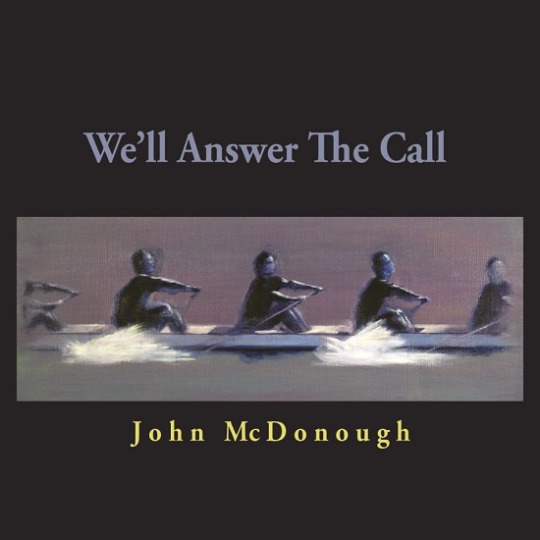
John McDonough is a singer/songwriter from Chicago, Illinois whose shows span six decades of hits combined with unique and moving originals. John’s acoustic guitar work, passionate vocals, and personal lyrics result in a modern singer/songwriter sound rarely heard. Before relocating to Chicago in 2020, John had spent 25 years performing in and around Austin, TX. He played to the rowdy crowds of 6th street, the dinner crowds of the suburbs, and everything in-between. Ten years ago John retired from psychotherapy to focus solely on music, and in that time has released five CD’s of original music, played over 500 gigs, performed in eleven major music festivals, several times appeared and performed on local and national radio, and embarked on successful tours throughout the United States. ‘Dream’s and Imagination,’ ‘Surrounding Colors,’ and ‘Can You See Me Now,’ released between 2014 to 2019, all received great reviews and airplay throughout Europe and the United States, with all three releases spending six consecutive months on the Americana Music Association Record Chart. Known for his emotional vocal delivery, his inspiring acoustic melodies and his moving lyrics, John McDonough enjoyed breakout success in 2021, with the release of his “Second Chances” album. Tracks from the acoustic collection received over 50K Spotify streams, earning him multiple industry awards nominations. His follow-up release, the 2022 concept EP, ‘We’ll Answer the Call,” raised the bar even higher: McDonough scored a #1 UK iTunes hit with the 2nd single, “Shooting Star” and a #2 with “Point Me East.” The latter also topped national radio airplay charts in the US, hitting #1 on the National Radio Hits AC40 airplay chart. The radio world is set and ready for his new and powerful “We’ll Answer the Call” (MTS).
Additional Artist/Song Information:
Artist Name: John McDonough
Song Title: We’ll Answer The Call
Publishing: John McDonough Music
Publishing Affiliation: ASCAP
Album Title: We’ll Answer The Call
Record Label: MTS
Record Label:
MTS
Larry Weir
3236587449
[email protected]
Radio Promotion:
National Record Promotion
Larry Weir
3236587449
[email protected]
Read the full article
0 notes
Text
New York's Most Eye-Catching Clothing Brands
New York is home of some of the most unique clothing brands on the planet. These brands are indispensable to anyone who loves fashion.
Sies Marjan is a New York-based brand that creates clothing specifically designed to show off your unique characteristics. The brand has a broad range of clothing, including an elegant and satin dress or plus-size pants.
1. Sies Marjan
Sies Marjan is a luxury ready-to-wear brand founded in the year 2016 by Dutch designer Sander Lak. After finishing his studies at Central Saint Martins, he worked at Dries van Noten until launching his own label.
His main focus is color, fit and fabric. He enjoys mixing unusual shades into his edgy designs.
It is a favorite among its fans and is well-known for its use of jewel toned and shining colors in its pieces. The brand resurfaced in New York in 2016 with bright rainbow colors, and quickly made an impression.
Although it closed its doors in 2020 its impact lives on. The Colors of Sies Marjan is a record of the five-year history of the label. Rizzoli edited it and included high-quality illustrations and notes, the best pieces and highlights from campaigns and collections. This chart tracks the brand's revolutionary path.
2. Tier NYC
Tier NYC was founded in 2014 by Brooklyn residents Nigeria Ealey, Esaiejean Simon, and Victor James. It is a striking clothing brand that gives a new take on fashion. Although they're not style designers, the founders of Tier NYC are proficient in graphic design and art, which is evident in their collection.
Their essential streetwear items include French Terry hoodies, tees shorts, sweatpants and hoodies that can be worn throughout the year. With an eye for specifics, they also make customized camo designs as well as utility design.
Ealey, Jean Simon, and James thought it was the right time to expand following their experience participated in Harlem Fashion Row's annual show. They opened a boutique of 975 square feet inside the Beverly Center in Los Angeles on Friday.
3. CD Greene
CD Greene is known for his made-to-measure dresses that accentuate the feminine figure by paying keen attention to embellishment. Every detail is designed with the customer in mind so that the dress never overshadows her.
His work can also be seen at Bergdorf Goodman, where his gowns are showcased in the amazing holiday window. The metallic-colored jumpsuit appears coupled with a model who plays the trumpet, while a second dress is on a flowing Mermaid model.
youtube
CD Greene's work pays homage to his creative roots in sculpture. The focus is on form, asymmetrical balance and the texture. His distinctive designs that are sculpted using crystal and mirrors are beloved by Hollywood royalty and pop stars alike.
4. Lemlem
Inspiring by a trip to her native Ethiopia, supermodel Liya Kebede established Lemlem (meaning "to bloom and grow" in Amharic) in 2007 to preserve weaving and create jobs for artisans from the region. The result is a fresh stylish, modern women's and kids' clothes line that's contemporary and distinctly African.
The label's net sustainable program guarantees that every piece is produced entirely by hand in Africa. This is a way to support local talent and keeps Africa's textile industry alive. Some of the label's eye-catching designs are the slinky gauze dresses and kaftans detailed with brightly embossed patterns.
5. Tia Adeola
Tia Adeola was the concept behind Teni Adeola born in Nigeria, a designer. She was born in London. The brand was launched from her dorm room using art history as an inspiration.
Her specialty is ruffles, the lace and lace which evoke the Renaissance. Every piece is designed with an feminine touch. Her ability to create striking clothes that make you feel like you're wearing art is another quality.
Adeola is a popular choice model for sexy style and her collection for fall/winter 2023 at New York Fashion Week showed the talents she has shown to be. She sent 20 looks down the runway, each playing off of another with synergy.
Watch the YouTube video
0 notes
Text
HDR Insights Article 3: Understanding HDR Tone Mapping
In the previous article – HDR Transfer Functions, we discussed the transfer functions and how digital images are converted to light levels for display. This article discusses how the same HDR image can be displayed differently by different HDR devices.
What is HDR Tone Mapping?
Tone mapping is the process of adapting digital signals to appropriate light levels based on the HDR meta-data. This process is not simply applying the EOTF (Electro-Optical Transfer Function) on the image data but it is rather trying to map the image data with the display device capabilities using meta-data information. Since a broad range of HDR display devices are available in the market, each with their own Nits (i.e. ‘brightness’) range, correct tone mapping is necessary for a good user experience. Since the tone mapping is done based on the meta-data in the video stream, presence of correct meta-data is necessary.
Source footage can be shot at HDR with best of cameras and then mastered on high-end HDR mastering systems, but it still need to be displayed optimally on the range of HDR televisions available in the market. Tone mapping performs an appropriate brightness mapping of the content to device without significant degradation.
Need for HDR Tone Mapping
Let’s say an image is shot with peak brightness of 2000 Nits. If it is displayed on a television with 0-2000 Nits range, the brightness range will be exactly as shot in the raw footage. However, the results will be different on other devices:

Since tone mapping is a necessary operation to display PQ based HDR content on HDR display devices, the television needs to know the native properties of the content in terms of the brightness range used along with mastering system parameters. This information is conveyed in the form of HDR meta-data. After reading the HDR meta-data, display devices can decide the tone mapping parameters so that the transformed video lies optimally within the display range of the display device.
Next article will discuss the specific meta-data for HDR-10 and HDR-10+, two different implementation of the HDR. Stay tuned for that.
Article 2: Transfer functions
Definitions
cd/m2 – The candela (cd) is the base unit of luminous intensity in the International System of Units (SI); that is, luminous power per unit solid angle emitted by a point light source in a particular direction. A common wax candle emits light with a luminous intensity of roughly one candela.
Nits – A non-SI unit used to describe the luminance. 1 Nit = 1 cd/m2.
HDR – High Dynamic range. It is a technology that improves the brightness & contrast range in an image (upto 10,000 cd/m2)
SDR – Standard Dynamic range. It refers to the brightness/contrast range that is usually available in regular, non-HDR televisions usually with range of upto 100 cd/m2. This term came into existence after HDR was introduced
WCG – Wide Color Gamut. Color gamut that offer a wider range of colors than BT.709. DCI-P3 and BT.2020 are examples of WCG offering more realistic representation of images on display devices.
EOTF – electo-optical transfer function. A mathematical transfer function that describes how digital values will be converted to light on a display device.
OETF – optical-electro transfer function. A mathematical transfer function that describes how the light values will be converted to digital values typically within cameras.
OOTF – opto-optical transfer function. This transfer function compensates for the difference in tonal perception between the environment of the camera and that of the display.
PQ – PQ (or Perceptual Quantizer) is a transfer function devised to represent the wide brightness range (upto 10,000 Nits) in HDR devices.
HLG – HLG (or Hybrid Log Gamma) is a transfer function devised to represent the wide brightness range in HDR devices. HLG is quite compatible with existing SDR devices in the SDR range.
This content originally appeared here on: https://www.veneratech.com/what-is-hdr-tone-mapping/
0 notes
Photo

12.9-inch iPad Pro: M1 chip, 5G capable, Magic Keyboard
With its sleek, neat, and efficient design, the iPad Pro showcases a fairly incredible new screen, which does not, however, manage to hide that the most dazzling innovation is the presence of SoC M1, the same chip that thrills the first Apple Silicon Macs.
Apple iPad Pro 12.9 Specification
Platform
System: iPadOS 14
Processor: Apple M1
RAM: 16 GB
Available storage capacity: 1000 GB
Memory card support: No
Display
Size (diagonal): 12.9
Screen definition: 2732 x 2048
Screen resolution: 265 dpi
Screen technology: LCD
Features
Wi-Fi support: Yes
Wi-Fi standard: 802.11a Wi-Fi, 802.11b Wi-Fi, 802.11ac Wi-Fi, 802.11g Wi-Fi, 802.11n Wi-Fi, Wi-Fi 6
Bluetooth support: Yes
Bluetooth version: Bluetooth 5.0
NFC support: No
USB connector type: USB Type-C
USB HOST: No
GPS
GPS chip: Yes
Camera
Main photo sensor: 12 MP
Communication
No Phone function but support 3G, 4G, 5G
Dimension
Width: 28.06 cm
Height: 21.49 cm
Thickness: 0.64cm
Weight: 684g
Apple iPad Pro 12.9 2021 1TB Wi-Fi + 5G
Sometimes an actor is so in the lead that it's hard to judge his progress. This could be the case with Apple and its iPad Pro, with no real rival in the world of pro tablets. Even while eyeing the side of hybrid PCs. A situation that is as much a result of the positioning of Apple's product, as of the reality of different hardware. And software ecosystems in the PC / Windows world.
However, with the iPad Pro M1, Apple has given birth to a product that is difficult not to see the evolution in leaps and bounds. From the display, a traditional strong point of Apple products, to the M1 chip that drives it. Everything shouts loud and clear that this iPad Pro is there to dominate the competition. And to further erase the border that sets it apart from MacBooks. More exactly, this iPad Pro continues to dig its third way between tablet and portable “PC”. It reinforces its versatile approach to personal and professional computing. Arrogates to itself the right to inaugurate mini-LED screens. While now playing with the same cards as Macs… except for a few details.

iPad Pro 12.9 image credit to Dbrand
Mini-LED screen: brightness and contrast
The exterior design of the iPad Pro remains unchanged, with fairly discreet screen borders although present. Vertical edges that are assertive and comfortable to handle. We note just a few tenths of a millimeter more in height, width, and especially thickness.
This last gain arrival of the new technology on the display side. Because yes, one of the big novelties of the 12.9-inch iPad Pro 2021 is in five words. And a lot of development efforts, we imagine mini-LED and Liquid Retina XDR. Those who follow the adventures of the Cupertino company with attention will have recognized. The name introduced with the professional screen from Apple, the Pro Display XDR.
But these three letters are much more than an economic denomination, they imply the respect of certain technical requirements. Thus, the panel must display a brightness of 1000 nits per cd / m2 when displaying HDR content. Peaks of up to 1600 cd / m2 can also be ensured when displaying some HDR photos. We measured them at 1531 cd / m2. Likewise, the required contrast ratio is extremely high (1,000,000: 1), close to an OLED panel. With reputedly infinite contrast offers since the black pixels do not emit any light. Strict specifications, therefore.
Screen
Our screen measurements partially confirm these theoretical figures. We recorded a base brightness of 606 cd / m2 (excluding HDR content). Which is very close to what the panel of the iPad Pro 2020 offered. And suggests that the 1000 nits are indeed guaranteed in the conditions. set out by Apple. We also noted a contrast ratio of “only” 60,600: 1, still on non-HDR content.
The use of quotes is important because it suffices to compare this score with that obtained. With the panels of the previous iPad Pro to realize the giant leap that has just been made.
Obviously, the mini-LED is at the heart of this progress. The more than 10,000 LEDs at work behind the display are grouped into more than 2,500 backlight zones. Giving better control of light scattering, showing much deeper blacks. And limiting effects unwanted such as blooming. Note, however, that we have noted some traces. This was particularly the case during films when subtitles were displayed on a particularly black background. Nothing catastrophic or crippling, obviously. But it's worth pointing out and doesn't undermine the fact that these display advancements are aimed. At enabling professionals to maintain an HDR production line from start to finish.

iPad Pro 12.9 image credit to Appleinsider
Color coverage of the iPad Pro M1, RGB space.
Obviously, the arrival of the mini-LED does not eliminate the technologies that Apple has developed over time. We, therefore, find the True Tone, which adjusts the white balance of the screen to the ambient light. In order to guarantee better comfort for your eyes. ProMotion, which varies the refresh rate of the panel from 24 to 120 Hz, is also there. At work so that the display fluidity adapts depending on whether you are watching a movie or playing Fantasian.
P3 technology, for a very wide color gamut, also always answers the call, and guarantees nuanced, rich, and faithful colors. Our measurements of Delta E 2000, which establish the difference between a displayed color and its true value. Show that Apple continues to excel. The 2020 iPad Pro gets a 2.2, in line with, a few tenths. What the two previous 12.9-inch Pro models offered.
You will understand that drawing, watching a movie, or playing on the iPad Pro is extremely pleasant. Especially since for these last two activities, the four stereo speakers greatly contribute to the immersion. Mini-LED backlighting technology does save the 2021 model a few hundredths of a millimeter, but this relative overweight is excused. The Liquid Retina XDR panel is a marvel.

iPad Pro 12.9 image credit to Pinterest
Powerful, like a Mac M1 …
But surprisingly, this is not what is getting the most attention. There is something amazing when you think about it. About finding the same chip in this iPad Pro that we discovered in the Macs ( mini, MacBook Air, and MacBook Pro ). Launched late last year, and in the recently arrived 24-inch iMac. It would be as if Apple had found the one-size-fits-all solution, the weapon of mass production.
An SoC with a performance/energy consumption ratio sufficiently optimized to fit. In a relevant way - into a wide variety of form factors. Because, apart from the addition of an active cooling system in certain devices, such as the MacBook Pro. The Mac mini, or even the iMac, the M1 chip integrated into all these devices and in the iPad Pro 2021 is identical. It arrives with its eight CPU cores (clocked for the most efficient at 3.2 GHz) and eight GPU cores. Its 16-core neural processor, and its maximum unified RAM limit, set at 16 GB.

iPad Pro 12.9 image credit to Tom's guide
8 or 16 GB of memory?
For the first time, Apple is offering two amounts of RAM for the same iPad Pro format. This calls for some clarification. When we ask Apple about the potential differences in performance between an 8 and 16 GB model. We are told that there are obviously some, but not necessarily as we understand it. Except in the very specific case of a particularly demanding application. The performance in a single task use will not vary. Where the 16 GB will make the difference is in the capacity of the iPad Pro. Just to keep more programs active in the background. To maintain a slightly higher responsiveness in the OS in general.
In addition, for the future, with the rise of applications, in particular. Those which use Metal and machine learning functions. Opting for a model with 16 GB will guarantee better performance.
In other words, opting for the iPad Pro 2021 with 16 GB. Namely, the two models with 1 and 2 TB (sold respectively from 1989 and 2429 euros) are only relevant. Apart from the storage capacity - if you use very demanding applications. Are a champion of multitasking or bet on the long term.
Memory
The fact that Apple has chosen to reserve this memory capacity for the most expensive models could (unfortunately) also make your choice easier.
After carrying out our usual tests, with our various tools, we, therefore. Decided to compare the performance of the 2021 iPad Pro with that of these two older siblings of the same format. The 12.9-inch iPad Pro 2018 (equipped with a chip A12X Bionic, and 6 GB of RAM). And 12.9-inch iPad Pro 2020 (with an A12Z SoC, also with 6 GB of RAM). For good measure, when possible, we added in the loop the MacBook Air M1, tested last November. Which therefore included an M1 and 8 GB of unified memory. The ultraportable has the advantage of not carrying a fan either. Which places it in a configuration quite close to that of the iPad Pro, with the obvious difference in the form factor.
With Geekbench 5, what do we see? First thing, that the iPad Pro 2021 displays almost identical performance to that of the MacBook Air. In other words, Apple makes sure that the power is not an argument of distinction between these two products. It is the versatility of the tablet, its ergonomics, the performance of its OS. And the accessories that will make you choose it over the MacBook Air if you are convinced. Like nothing, Apple is putting some pressure on itself by doing this. Because iPadOS is really going to have to improve greatly to make the iPad Pro more than an excellent tablet. But also a laptop capable of competing with a MacBook Air running macOS Big Sur. We will come back to that.

iPad Pro 12.9 image credit to 9to5 mac
iPad Pro 2021: what is the Apple M1 worth?
Second point of observation, the iPad Pro 2021 largely dominates its predecessor. With respectively 53.7 and 55.5% performance gain in single and multi-core. The case is heard, the M1 is much better than the A12Z.
When we look at Metal performance, from the graphics part to put it simply. The gain goes to 115.5%, so it is more than a doubling of the capacities of the iPad Pro 2021 in this area.
To moderate these figures a little, if we look at AnTuTu 8, we observe slightly less good progress. For the overall score, however, a plus 39.1% is recorded. While for the various detailed sub-scores, the gains oscillate between 35.5 and 47.2%. This last result attribute to RAM. The quantity of which more than doubled between our two test models.
Apple is also increasingly emphasizing the capabilities of the neural network integrated into its SoCs. The use of machine learning is strongly encouraged among developers working in its ecosystems. We, therefore, compared the three generations of tablets with a new tool, Geekbench ML. Which measures the performance of machine learning algorithm computation with the processor. The graphics processor, and with Core ML, the tool made available to developers. by Apple.
Here again, the iPad Pro 2021 largely dominates the 2020 model. CPU and GPU side, these are gains of around 44% that we record. While the Core ML part shows a plus 90.2%. Apple is therefore serious when it says that its M1 chip optimizes to give the best of itself for uses. And functions based on the use of “artificial intelligence” algorithms.

iPad Pro 12.9 image credit to debudder - medium
Power and thermal limit
We will complete this avalanche of synthetic tests with 3Dmark Wild Life. A benchmarking tool that has several advantages. Not only does it estimate the graphics capabilities of a platform, but it also incorporates a stress test. It is in fact a matter of running the same grueling test in a loop, for about twenty minutes, and then of noting the differences in performance between the results obtained at each rotation. A stability score is then assigned to the tested devices.
When we subject the iPad Pro 2021 to the first part of this test, it conscientiously crushes its elders, with a score almost 70% higher. We can therefore applaud the M1. However, all is not rosy - by the way, the iPad Pro is only available in space gray and silver.
Because, when we look at the results of the stress test, we see that the amazing performance of M1 is no longer the order of the day. The scores obtained for the best and worst test loop by the iPad Pro M1 are between 49.5 and 57.6% lower than those recorded with the iPad Pro 2020, with its A12Z.
A difference in behavior in the face of throttling (when a processor reduces its performance because it heats up too much) summarized by the stability score attributed by 3Dmark Wild Life: 95% for the iPad Pro 2020… 79.8% only for the 2021 model.
Apple M1
It seems that we are therefore reaching the limits of the magic of the M1 with the very compact case of the iPad Pro.
Nevertheless, once detailed all these test results, it is obviously necessary to give a little feeling "of the daily". The famous "iPad experience" is assured without a hitch. The interface is fluid, the applications launch quickly, even the heaviest. The best-known productivity apps run without the iPad Pro even seeming to have to exert an effort. The games run with ease and ease. The use of a controller is strongly recommended, especially since it is now possible to synchronize the gamepads of the Xbox Series and PlayStation 5, in addition to those of the previous generation consoles. No more excuses not to chase coins in Crossy Road Castle for four or to explore the all-new Fantasian, the latest game from Final Fantasy creator Hironobu Sakaguchi.
In short, you will understand, the iPad Pro 2020 was not lacking in power, its successor raises the bar even higher, with a caveat, and should hold the course for a long time to come.

iPad Pro 12.9 image credit to pocket-lint
Autonomy, progress where it is needed
Traditionally, when you slip an ultra-powerful setup into a compact and portable device, a worried eye turns to the battery life result, because performance and endurance don't mix very well.
The collateral effect of the "magic of M1" or more sure of the frenzied work of Johny Srouji's teams, the case of the iPad Pro 2021 is an exception.
It is true that in video autonomy, which sees the iPad streaming a file until its battery gives up, we note a decline of just under an hour, the 12.9-inch iPad Pro M1 holds 10:42 a.m., compared to 11:39 a.m. for the previous generation.
On the other hand, when we turn to our versatile autonomy tests, which intensively simulate our daily uses: Web, video, etc., we see very clear progress between these same two models. The new iPad Pro M1 lasts 13:32, where its predecessor died at 11:49.
As you can see, in any case, the iPad Pro 2021 does better than the iPad Pro 2018, equipped with the A12Z.
Beyond these tests, in use, if you do not abuse the brightness and 5G (Wi-Fi remains the most energy-efficient), your iPad Pro should accompany you for a good part of your day. to work, play quietly, listen to music, and watch a few series.
Finally, be aware that if the iPad Pro 2021 is not one of those devices that recharge from 0 to 100% in less than an hour, it is also progressing slightly in this area, since it only takes 2h49 against 2h58 previously. Progressing won't change your life, but a few minutes saved is always a good thing to take.

iPad Pro 12.9 image credit to Apple
So a laptop?
All of this leads to a question, always the same when you consider the iPad Pro across Apple's offering: is it capable of competing with MacBooks? Can he replace them?
If we put aside the thorny issue of price, we must take into account several points, which could be classified a little quickly under the name versatility.
Because, now that the iPad Pro shares the same chip as the last entry-level MacBooks (Air and Pro 13 inches), the question of the possible difference in power is largely resolved. We must therefore consider the possible uses with all the more attention.
However, on paper, and in fact, the iPad Pro 2021 is much more versatile than a MacBook Air. Let us list some more or less essential points which can motivate a choice.
There is of course the touch, to begin with, with the possibility of using a second-generation Apple Pencil to take notes or draw, two activities unthinkable on a Mac, without using at least one external tablet.
Unlike Macs, the iPad Pro also benefits from a cellular connection. Better, for the first time, the Apple tablet is compatible with the 5G standard, in addition to 3G / 4G - admittedly, compatible mobile networks are still in their infancy, but the iPad Pro can in fact stay connected. to the Internet even when it does not have access to a Wi-Fi 6 network. For users who travel regularly, this point can therefore be important.

iPad Pro 12.9 image credit to Apple
The Thunderbolt / USB 4 port is obviously used to power the iPad Pro M1, but also to connect many peripherals.
The addition of Thunderbolt / USB 4 support also opens up the iPad Pro to new accessories and therefore new uses, further integrating the tablet into certain productivity cycles.
Thus, being able to connect high-performance external hard drives makes it easier to consult heavy documents on the move, for example, if we imagine that the iPad Pro is the terminal that a professional wants to take with him rather than a MacBook Pro.
Likewise, it is now possible to connect a 6K screen (at random, the Pro Display XDR) to the iPad Pro, with the limit that it is the applications that manage individually if this second screen is a mirror of what is displayed. on the tablet or an extension of the display surface. On this point, we would like the OS to take the lead to offer a unit of experience.
The rise to 2 TB of storage space also pleads in favor of an iPad Pro which is not only a terminal of limited consultation or creation. With such a capacity, it is quite conceivable to store 4K rushes by shovel, professional photos for a first edit, or even 3D models, tweaked or reviewed during a journey.
Camera
In a pandemic world, the iPad Pro also incorporates a much better front camera to ensure hours of professional and friendly video conferencing, which are not going to be definitively replaced by face-to-face meetings in the immediate future. Moreover, the new TrueDepth module of the iPad Pro 2021, an ultra-wide-angle associated with a 12 Mpixel sensor, offers a viewing angle of 122 degrees which allows the introduction of a useful and fun novelty: Center Stage.
This automatic function ensures that when you chat in video conference via FaceTime or equivalent, the framing will follow you to place you as much as possible in the center of the field. So you can move around a bit in your seat or move around the room without immediately getting out of the frame.
Small demonstration of Center Stage and its follow-up.
Obviously, the TrueDepth camera is not motorized to move, it will no longer follow you if you move too far to the sides.
In addition, the new front module adds Portrait mode to its arc, so it is possible to take advantage of the bokeh effect or the different lighting modes that recent iPhone users are now accustomed to.
To stay in the world of cameras, and if we look at the back of the iPad Pro, there are always two modules: a wide-angle (12 Mpixels) and an ultra-wide-angle (10 Mpixels) capable of filming in 4K. This can turn the iPad into an add-on camera or camera, not necessarily for photographing your vacation, but for quickly scanning a document, photographing an object to embed in a file, etc. A flexibility that is not offered by MacBooks without the intervention of an iPhone.
And that's without counting also on lidar and augmented reality experiences, educational and fun, for the general public, and for the purposes of productivity or creation for professionals.
Apple's Magic Keyboard is now available in white.
And since we're talking about productivity, let's take a look at the Magic Keyboard, an accessory (unfortunately not very versatile) that physically transforms the iPad Pro into a laptop. In addition to the 2020 model being compatible with the iPad Pro 2021, the new generation of keyboards offers the same backlit typing comfort, the same flexible and rather a short stroke, and the same gestures via its trackpad. We will just be surprised at the existence of a white keyboard shell. As much as we can consider not spilling a slice of chocolate on the keys, it seems difficult to preserve the outer part of the shell from the usual dirt from the bag bottoms.
From a physical point of view, the Magic Keyboard finishes making the iPad Pro a MacBook killer, but this year again, it is the software, iPadOS, in this case, which will make us express reservations. Even when working task after task, switching little from one application to another, or worse from several applications to several others, we do not find the efficiency offered by the free and floating window of macOS. Everything is there, the touch screen or the keyboard and the trackpad when it's the fastest solution, but there are still a few small things missing on the side of the iPad OS interface.
And, then, we can also remember that, unlike macOS which leaves a great deal of freedom - especially on the origin of applications or the choice of browsers, iPadOS is much more locked and quick to control our impulses.
So, once again, is the iPad Pro a good possible replacement for a MacBook? The answer is more and more "yes", and the "but" smaller and smaller.
We are here to hear from you
Of course, you can contact us to let us know if we are missing something on our stepphase.com page. I hope you like it and by the way, thank you for your visit.
#Stepphase #technologies #technology #tech #technews #techworld #techtrends #smartphone #apple #techupdates #futuretechnology #newtech #techgeek #technologynews #technologythesedays #smarttechnology #technologylover #technologytrends #technologyblog #gadgets #smartphone #gadget #marketing #digital #india #technologyisawesome #amazing #repost
0 notes
Text
Data Sure is Neat, Part 2

How much information does your typical book hold? If you haven’t read it yet, go back and read our last blog about how much data is stored in the Library of Congress, then come back here to learn more about the everyday applications of data and how much we store on a day-to-day basis.
Examining the Bit
Data is made up of bits, or strings of ones and zeros. There are 7 bits in English characters and 8 bits in a byte.
Data is stored in ones and zeros because that’s the way we have been doing it for the past 70 years. We like to use the example of a machine that has seven lights on it to represent data. If the light is on, then it’s a zero, and if it’s off, it’s a one. The combinations of lights translate into various characters, like letters, numbers, and symbols, and when strung together in large arrays, can represent vast quantities of data to be read by a system.
Magnets use this method to store data, and they are the backbone of the present-day hard drive. With spinning platters that look an awful lot like a stack of CDs, the hard drive uses magnets to read and write data to the drive. These devices are sensitive and can detect something as tiny as something billions of times smaller than an eyelash cut into a hundred different pieces. Pretty shocking stuff.
Basically, the hard drive was crucial to the development of data storage, and it remains to this day a common staple in the office environment and even for consumer electronics. Solid state drives, or SSDs, are also quite popular, and they run using electrical charges to tiny transistors. Since they don’t rely on mechanical movements or magnets, they are the preferred choice for mobile devices, tablets, and laptops, and they can run a lot faster than your average desktop computer HDD as a result.
How Much Data is Contained On Your Smartphone?
If the US Library of Congress holds 51 Terabytes, how much does the average smartphone hold?
A typical high-end smartphone has about a quarter or half a terabyte, but if your smartphone has a Micro SD card slot, you could potentially expand its storage by an entire terabyte. That is about a 50th of the Library of Congress, or over a million books. It’s pretty shocking, considering how small those little guys are.
Here are just a couple of ways you can use a 1 Terabyte Micro SD card:
200,000 songs
250 full-length movies in full HD
5 million pages of PDF documents
250,000 photos taken with a 12 megapixel camera
Essentially every video game from the 80s and 90s.
Or you could store 10,000 copies of Windows 95 and Microsoft Office 95.
How Much Data Does Humanity Produce?
Humanity has produced 44 zettabytes as of 2020, and this would require 44 billion 1 TB Micro SD cards. This number could double by the end of this year, and by 2025, it could exceed 200 zettabytes. Absolutely mind-blowing.
Considering the fact that more than 62 percent of all people on the planet use social media, send emails, move information from one point to the next, and so on, this isn’t that surprising. With 300 billion emails sent daily and over 500 hours of YouTube content uploaded daily, data generation is not slowing down anytime soon.
Look, Data is Important
We hope that this look at data generation has made you look at your own data in a different light. Yes, new data is created all the time, but you can save a lot of time and energy by protecting the data you already store with data backup and disaster recovery solutions. Failing to do so is like doing the same work twice; there’s no reason for it, so don’t do it.
Infradapt can be your go-to resource for data backup solutions. To learn more, contact us at 484-546-2001.
https://www.infradapt.com/news/data-sure-is-neat-part-2/
0 notes
Text
How Docker & Kubernetes Can Optimize the Cost of Hosting?

Container orchestration and container technology are revolutionizing the management and deployment of applications in a multi-node distributed domain at scale. After Google open-sourced Kubernetes in 2014, many tech organizations worldwide have chosen to leverage this container platform’s benefits, increasing recognition and popularity in the tech arena.
In 2019, we saw a wide agreement that containers controlled by container orchestration structures make the board, application CI/CD and sending at a scale much more productive and effective.
But, containers’ real benefits and functional advantages are often covered up under a layer of typical terminologies known to only a few specialists in the field.
What is Docker and Kubernetes container? Don’t worry; we will help you uncover and understand these container terminologies.
What is Kubernetes?
It is an open-source container-orchestration system used for automating app management, scaling and deployment. Kubernetes is designed by Google, and now it is handled by the Cloud Native Computing Foundation. Undoubtedly, it is a trustworthy container system ruling the market.
According to the CNCF survey, the utilization of Kubernetes in production in 2020 was 93%, up from 78% in 2019.
Since Kubernetes is a widely utilized Docker containerization platform, it is intended to work and support all container technology that meets the standards of Open Container Initiative (OCI).
What is Docker?
Now come to know what Docker technology is? It is a tool that utilizes OS-level virtualization that assists in developing, running and deploying apps by using containers.
Containers are not similar in nature, feature and contain the essentials to run an application: program, system tools, system libraries, runtime, and settings. Containers like Docker interact with each other via well-defined and needed mediums.
Cost-Saving Benefits of Containers
We know how container structure protects more efficient use of resources than VMs. But, containerization cost-saving benefits are limitless and don’t end there.
Let’s check how Docker & Kubernetes can optimize the cost of hosting
1. Containers are free and open-source
Widely used container platforms like Docker are free and open source to use. They are developed around standardized technologies such as user namespaces, systemd, cgroups and other Linux libraries and concepts and open-source Linux distributions that assist OS-level virtualization and container isolation. However, while some VMs like KVM are free to use, others like VMware are very costly when used on a large scale.
2. Lower management and configuration costs
The time has gone when containers require teams to spend much more time and cost. In this post-container era, configuring and managing servers has become very cost-effective.
Professional docker consulting firms can assist you in leveraging the benefits of low management and configuration cost while using containers.
Now containers have all dependencies packaged, self-contained and portable to run; they are less reliant on the dedicated server configuration and environments.
Also, containers today are no longer jumbled with the host environment. As a result, you can save more money and time on server configuration with networking, system libraries, environmental variables, dependencies etc.
3. Lower infrastructure costs
Now we know that containers can be faster and more lightweight than VMs, which are immutable. OS-level virtualization utilized containers to enable deploying several containers on a single host. Docker and Kubernetes-like containers don’t need duplicate OS images to run.
4. Better teamwork between infrastructure engineers and developers
Container technologies make better teamwork and cooperation between infrastructure engineers and developers. Developers can easily create the app, package it into the required container with all settings and dependencies, and then hand it over to infrastructure engineers that only require knowing what storage and network requirements the container has.
These engineers are no longer required to install all these dependencies manually and tune the server for app functioning. The container will utilize the internal and self-contained settings to coordinate with the host kernel and utilize the required resources.
5. Efficient resource management
Kubernetes uses a highly efficient resource management model run at the cluster levels, pod, and container. At the container level, developers can easily limit specified raw RAM and CPU values and assign resource requests to containers.
All such factors control the maximum and minimum amount of available resources to the container during its lifecycle. ByBesetting a varied number of limit/request rations, you can make different classes of pods – assured, burstable, and best-effort – relying on the needs of your app.
Additionally, Kubernetes backs namespace-wide resource management, enabling you to define default resource requests, request quota, and resource constraints in a given namespace.
In this way, you can assure that your cluster always has the required resources to decrease cloud infrastructure costs for running applications.
6. Low maintenance costs
Containers include environment parity of product development, testing and deployment. All these environmental factors are uniform with containers. It results in huge cost-saving benefits as uniform environments offer easier maintenance even with smaller teams.
Conclusion
Finally, we can say that Kubernetes and Docker have immense cost-saving potential. A Docker development consulting helps to better utilize containers to decrease infrastructure and hosting costs.
Containers can share a single OS and are lighter than VMs. Additional benefits of containers include low maintenance costs, better coordination between engineering teams, faster CI/CD pipelines.
With Kubernetes like container technology, you can save more with rolling updates, efficient resource management, application scheduling, and scaling.
SB- 9series
0 notes
Text
Cracking the Code of Disc Archiving

For many data storage environments, data archiving is an essential process for a number of reasons. First, either long-term or short-term data archiving enables a business to access archived files and retrieve a specific piece of data for clients or for internal use. Second, due to governmental regulations, data archives are frequently kept for a specific period of time. In light of this, businesses typically have three options for data archiving strategies: disc archiving, tape archiving, or both. Which method has advantages and disadvantages? Which is preferable for your business? Or is combining disc and tape for your data archiving the best option?
Many organisations frequently choose a combination of disc and tape, using disc for short-term archives and then transferring archived data to tape for long-term retention. There are several benefits and drawbacks to both disc archiving and tape archiving.
How can you benefit from CD, DVD, and Blu-ray disc archiving?
One of the most significant challenges that businesses will continue to face in the coming years is the explosive growth of unstructured data. Simply increasing primary storage will no longer be sufficient to address this issue due to technical and economic considerations. Due to the fact that the majority of unstructured data is inactive, businesses are increasingly looking for solutions to this problem.
In 2020, 44 ZB of digital data are anticipated to be produced globally. This does not imply that all of that data will necessarily need to be stored. However, the global trend toward larger data holdings by individuals and organisations will continue. The trend forecast for storage device capacity in the enterprise market, including data centers.
Be aware that storing cold archives takes up about 90% of the total capacity (active archives plus deep archives). Cold data grows as the amount of produced data grows over time, necessitating an ongoing increase in storage space.
How are CDs, DVDs, and Blu-ray discs read by computers?
After bouncing off the disc, a laser beam strikes a sensor. By analysing the intensity of the reflected light, the computer can determine whether the laser was pointed at a pit or a flat area on the disc's surfaceer was pointed at a pit or a flat area on the disc's surface. Pits (indented areas) stand in for 0s, and lands (unintended areas) for 1. Since the only characters in computer code are 0s and 1, any type of data can be used. CDs, DVDs, and Blu-rays contain specific data arrangements that are hard-coded to look for in those devices for playback on specialised devices.
Features of CD, DVD, and Blu-ray Disc Archiving
Protection of Personal Information
Secure and long-term data usage and storage
Data optimization (also known as data optimization)
Data Security and Compliance Data availability of one hundred percent is achieved through storage efficiency
The Evolution of Data Archivers
Off-line archiving had previously relied on recording media with single optical discs, buy Panasonic's Data Archiver is unique in that it can handle the demands for cold archives for data with more than dozens of PB in a sizable data center. As was already mentioned, the use of optical discs in the enterprise market has increased quickly as a result of new applications created to meet this demand.
The bare minimum configuration consists of one base module (magazine reading and writing device), one extension module, and one bottom module (magazine transfer device) (with a writer unit). Up to 76 3.6-TB magazines can be mounted in the base module, and it can add extension modules with writer units to accommodate growing data storage requirements.
Sustainable Storage's Social Impact
80% of the data produced in today's society will be converted to "cold data." We would use a lot more power and emit a lot more CO2 if we continued to use storage media that was not designed for long-term archiving. We should give this careful thought because the social information infrastructure choices we make can have a big effect on the environment.
Optical disc archives have a low power requirement and don't require frequent data migration or air conditioning. Data can also be preserved for a very long time—50 to 100 years. Consequently, optical disc archives are the most environmentally friendly storage medium at this time. It's time to hasten the development of environmentally friendly optical disc storage systems.
The Function of CD, DVD, and Blu-ray Disc Archiving
In Intelligent Libraries and Network Attached Appliance Solutions (with the exception of 3rd Party Software for Library Management and Storage Virtualization), the durability of Blu-ray Archive Storage is combined with the speed of hard discs.It is crucially important to keep digital data safe and secure for the long term, especially with the growing amount of content produced each year. When low-cost data storage solutions are required, optical disc-based systems for offline data archiving are crucial. For long-term data storage and important data backups, optical discs are a fantastic option.
As a workaround, you can archive data onto secondary storage devices made for long-term, high-volume data storage, like Blu-ray Disc archiving and storage devices. The Olympus Series Archive Edition offers a simple programme for automatic policy-based migration of cold data from primary storage to archival Blu-ray Discs, which may then be kept offline in the DiscStor 900 smart disc storage cabinet. It is easy to install and use.
Final Reflections
The All Pro Solutions consultancy specializes in measuring IT infrastructure efficiency to reveal the substantial savings your company can make. Additionally, our Blu-ray Disc archiving systems guarantee data security, whether it is kept on hand to fulfil legal obligations or safeguard corporate property. Overall, All Pro Solutions Archiving and Storage solutions reduce the cost of archiving, simplify recall, securely store, and safeguard critical data for decades—all while operating entirely offline.
Whatever kind of data archiving is necessary, All Pro Solutions has the best option for your circumstance. We offer systems that let you store software source code, log files, emails, and office documents, as well as video or medical images that have been recorded on your computer.
0 notes
Text
Conclusion/Bibliography
To conclude, women are strong forces of nature to be reckoned with but we too can only take so much, and honestly, we have had enough. We’ve had enough of pregnant Samoan women being treated unfairly based on their social factors, the stereotypes placed on Samoan women with disabilities, the non-consensual sexual effects on Samoan women’s health, how the Samoan community use god to belittle Samoan women, gender roles within the Samoan community, hurting instead of helping our Samoan women within healthcare, etc. I understand being tired of seeing no results and feeling as if you are “wasting your breath” but it is all a process to something much more divine.
These issues I presented were terrible conditions that no woman should have to go through, but the results did start surfacing. More women are becoming doctors/nurses, in the healthcare system and they are of color so that comfort we want so much? It is becoming more of a given. There are now discussions, focal groups, and training put in place to help the Samoan women with disabilities and that have been abused strive and get the support they so desperately yearn for. The rates of STI/STDS in Samoan women dropped significantly after women in healthcare spoke up about the rates of suicides, the effect of abuse, and the significance of ensuring women's safety, etc.
Pain and hurt can never be taken away as much as we want it to be. If I could I would take the heartache away from every woman I’ve met. Results aren't always black and white because that is not the world we live in. It is okay to not be okay with the outcome but the ultimate fulfillment is when the process finally makes it all worth it. Keep fighting, keep speaking up, and keep going for the “underdog” because after all, it is the underdog that always rises to the occasion!
Carney, Robert. Gafa, Judith. Howells, Michaela. Matalavea, Athena. Tanumafili, Aaone. and Toleafoa, N. Tate. 2020. “Comparing age and sex trends of chlamydia, gonorrhea, hepatitis and syphilis infections in Samoa in 2012 and 2017.” Journal of Western Pacific Surveillance and Response 11(1).
https://www.ncbi.nlm.nih.gov/pmc/articles/PMC7485517/
Dianne N. Ishida, Ph.D.Tusitala, F. ToomataMayer B.S.Nafanua. 2001. beliefs and attitudes of Samoan women toward early detection of breast cancer and mammography utilization.
https://acsjournals.onlinelibrary.wiley.com/doi/full/10.1002/1097-0142%2820010101%2991%3A1%20%3C262%3A%3AAID-CNCR16%3E3.0.CO%3B2-R
Donnelly, P. 1992. Samoan women’s voices: alternative ways of doing birth (Thesis, Doctor of Philosophy). The University of Otago. Retrieved from
http://hdl.handle.net/10523/3590
Secretariat of the Pacific Community United Nations Population Fund Samoa. 2006. The Samoan family health and safety guide.
https://www.google.com/url?sa=t&rct=j&q=&esrc=s&source=web&cd=&ved=2ahUKEwjxpf6TgrT7AhXzJ0QIHaSKA6gQFnoECAwQAQ&url=https%3A%2F%2Fpacific.unfpa.org%2Fsites%2Fdefault%2Ffiles%2Fpub-pdf%2FSamoaFamilyHealthandSafetyStudy.pdf&usg=AOvVaw0ohIuDgUSeQgaUG6i2qYr9
UNFPA PACIFIC. 2022. Needs assessment of people with disabilities in Samoa.
https://pacific.unfpa.org/en/publications/needs-assessment-people-disabilities-samoa
Yamada AM, Vaivao DES, Subica AM. Addressing Mental Health Challenges of Samoan Americans in Southern California. 2019. Perspectives of Samoan Community Providers. Asian Am J Psychol.
https://www.ncbi.nlm.nih.gov/pmc/articles/PMC7992925/
1 note
·
View note